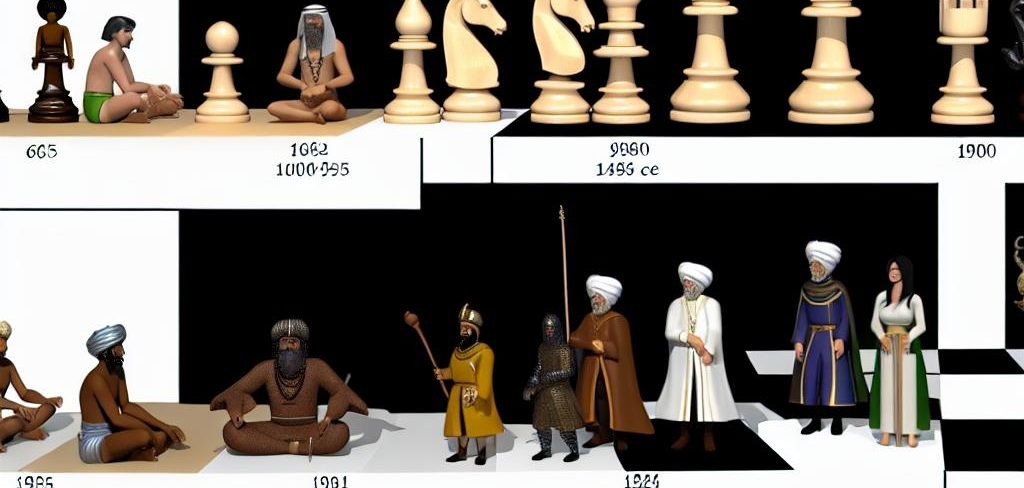The Ancient Origins of Chess
The history of chess is both intriguing and complex, as its origins stretch back to the 6th century. It is widely believed that chess originated in northern India, during the Gupta Empire, where it was known as Chaturanga. This ancient game bears similarities to modern chess, featuring four divisions: infantry, cavalry, elephants, and chariots, which evolved into the modern chess pieces.
The game spread to Persia, where it became known as Shatranj. From there, it made its way to the Islamic world and later to Europe. The rules and pieces of Shatranj were slightly different from what we are familiar with today. The spread of chess occurred primarily via trade routes and conquests, which facilitated the transformation and adaptation of the game across different cultures.
The Evolution of Chess in Medieval Europe
As chess spread to Europe by the 9th century, it underwent significant changes. The game began to take the shape of the modern version during the medieval period, with modifications to the rules and a distinct emphasis on strategy and tactics. The pieces were redesigned to reflect the courtly society of medieval Europe. For example, the Elephant evolved into the Bishop, and the Vizier changed into the Queen.
Around the 15th century, particularly in Spain and Italy, the game morphed into its modern form, often called Queen’s Chess, named after the piece that had gained the most power in the game. These changes significantly increased the pace of the game, making it more dynamic and popular among the European aristocracy.
The Rise of Competitive Chess
The 19th century marked the formalization of chess with standardized rules and the establishment of tournaments. The first modern chess tournament was organized in London in 1851. It was during this period that notation systems were devised, enabling better recording and sharing of games, including the introduction of time controls.
The first World Chess Championship was held in 1886, with Wilhelm Steinitz recognized as the first official World Chess Champion. This was a landmark event in chess history, setting the foundation for professional chess competitions and a structured ranking system.
The 20th Century: Expansion and Cold War Influence
Chess experienced a significant boom during the 20th century, with rapid developments in chess theory and the emergence of legendary players. Notably, the Cold War era saw chess being utilized as a proxy battle between the United States and the Soviet Union. The famous 1972 World Championship match between Bobby Fischer and Boris Spassky symbolized this rivalry, captivating an international audience.
This period also saw the introduction of computers into chess, with the first computerized chess games appearing in the 1950s. By the late 20th century, computer programs had reached a level where they could challenge even the best human players, culminating in the famous victory of IBM’s Deep Blue computer over World Champion Garry Kasparov in 1997.
Modern Chess: The Digital Age
Today, chess continues to thrive both as a sport and a cultural phenomenon. The emergence of online platforms has revolutionized the accessibility of the game, allowing players worldwide to compete against each other at any time. Resources for learning and improving are widely available, from educational websites to chess.com, where enthusiasts can play, study, and engage with a global community.
Moreover, chess has maintained its prestigious status through international competitions such as the Chess Olympiad and the ongoing FIDE World Chess Championship. It remains a symbol of intellectual prowess, critical thinking, and strategic acumen. As technology advances, the landscape of chess will likely continue to evolve, yet its rich history provides a solid foundation for its enduring appeal.
The Influence of Chess on Culture and Society
Chess is not only a game but also a reflection of cultural exchanges and societal structures. Throughout its history, chess has mirrored the political and cultural landscapes where it has been played. This is evident from its origins in the Gupta Empire, where it symbolized the military and strategic planning, to its later transformation in medieval Europe, where the pieces adopted roles representative of feudal societies.
As chess moved westward, it brought with it stories and knowledge from the East, acting as a vessel for the intellectual treasure troves of ancient India and Persia. It became a medium through which various cultures could interact, share ideas, and influence one another. The incorporation of different rules and piece movements is a testament to the mingling of ideas across borders.
Chess as an Educational Tool
For centuries, chess has been recognized as a valuable educational tool, developing not only strategic thinking skills but also patience and concentration. It is often utilized in educational settings to enhance problem-solving abilities and improve cognitive functions. The correlation between chess and cognitive improvements has been subject to numerous studies, supporting its incorporation into academic curriculums.
Moreover, chess can serve as a metaphor for life, representing decision-making, foresight, and adaptability. Its complexity offers lessons in planning and consequence analysis, which are applicable beyond the chessboard and into everyday life situations. Many educators and psychologists advocate for chess as a mechanism to enhance intellectual growth and social skills.
The Role of Chess in Modern Technology
In the modern era, technology has played a crucial role in the evolution of chess. The capabilities of computers have allowed for advancements in chess strategies and analysis that were not previously possible. Modern chess engines can analyze millions of positions per second, providing insights and strategies that have reinvented how the game is approached at every level.
Online chess platforms have democratized access to competitive chess, breaking geographical and social barriers. Players from different backgrounds and skill levels can engage in high-level matches, receive coaching, and study grandmaster games. This digital revolution is perhaps one of the most significant changes in chess since its inception.
Chess engines, such as Stockfish and AlphaZero, have not only transformed competitive chess but have also contributed to advancements in artificial intelligence and machine learning. These engines learn and adapt in ways that mimic human learning processes, offering a glimpse into the future of AI development.
The Future of Chess
Looking ahead, chess is poised to maintain its relevance in both traditional and modern contexts. The introduction of new formats and technologies continues to attract a diverse audience, from casual players to professionals. Virtual reality and augmented reality could further innovate how the game is experienced, offering immersive learning and playing environments.
Furthermore, the growth of online tournaments and streaming channels—where players and enthusiasts can broadcast and discuss games in real-time—has expanded the reach and influence of chess significantly. Platforms like Twitch have become popular venues for chess content, attracting millions of viewers and increasing engagement with the game.
As the global interest in chess continues to rise, its impact on education, technology, and cultural integration is expected to deepen. The game remains a timeless challenge, symbolizing both a connection to the past and a bridge to the future.
Conclusion
The journey of chess from its ancient origins to contemporary times is a testament to its adaptability and enduring appeal. It has evolved from a game symbolizing warfare strategies to a global phenomenon representing intellectual acumen and cultural exchange. Chess remains an engaging and multifaceted pursuit, offering challenges that appeal to a wide spectrum of enthusiasts.
Its rich history and continued evolution ensure that chess will remain an integral part of educational, cultural, and technological landscapes. As players delve into the complexities of the game, they not only engage in a timeless tradition but also participate in a continually unfolding narrative that reflects the very essence of human ingenuity and creativity.



